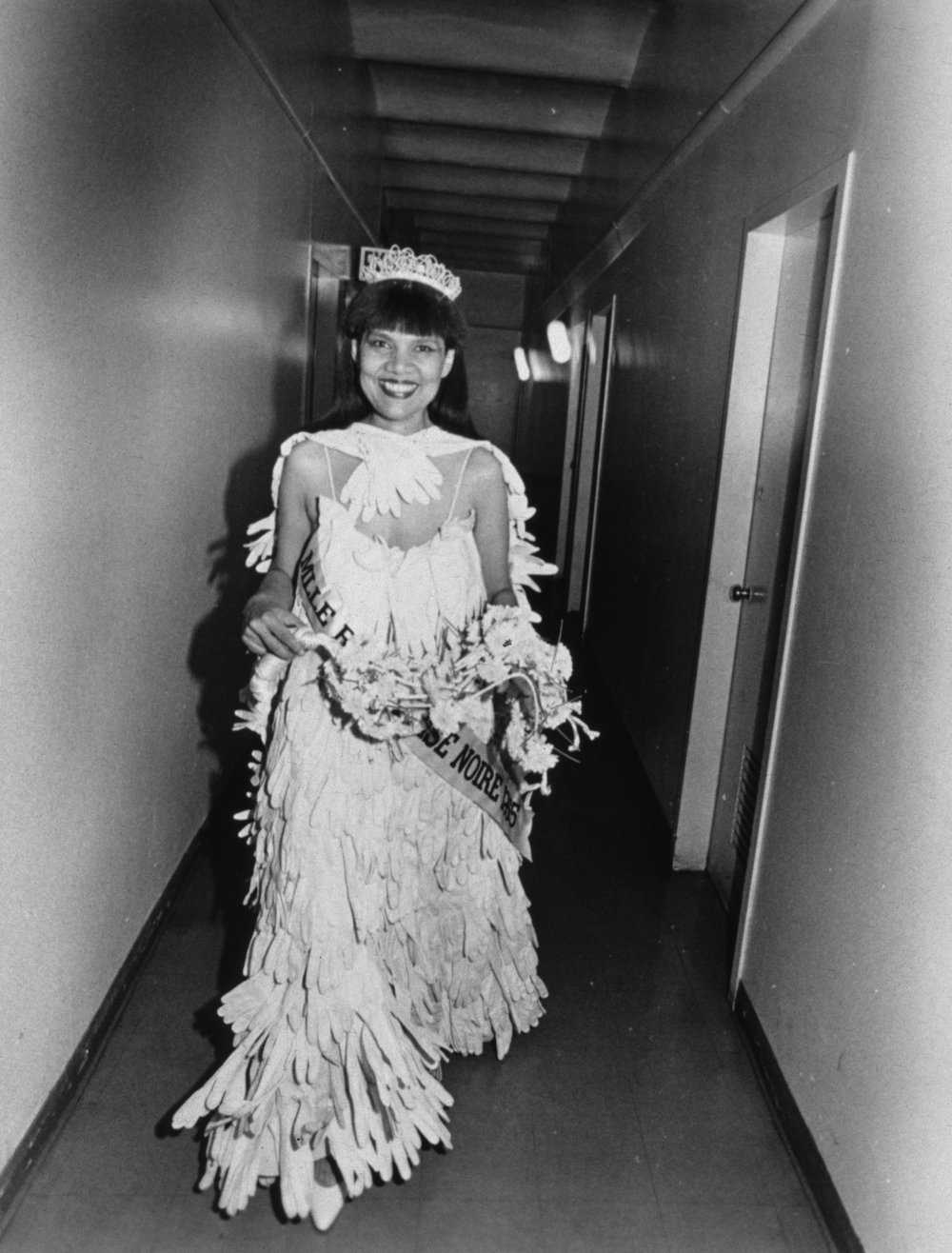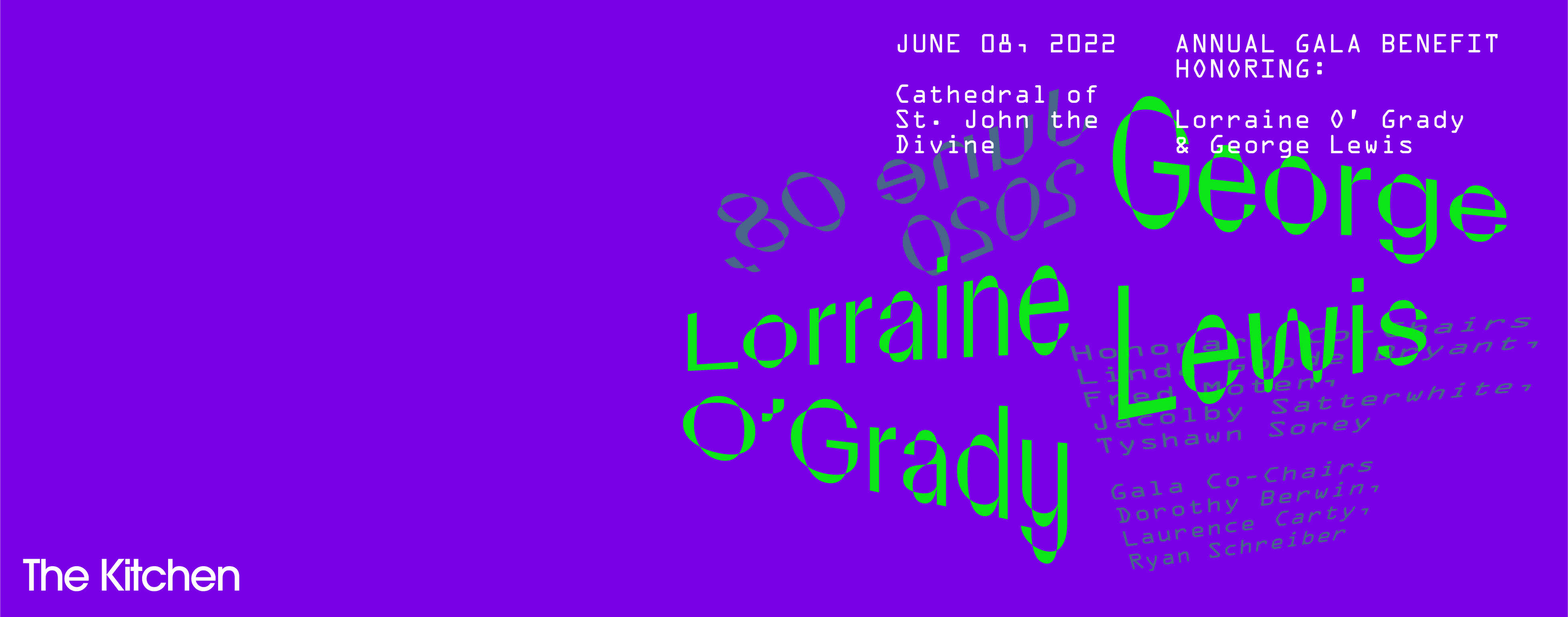
Credits:
By Susana Plotts-Pineda, Winter/Spring 2022 Curatorial Intern
October 10, 2008
“From the Archives” is a series that spotlights The Kitchen’s history. As a complement to our Archive Website, these posts offer focused reflections on the artists, exhibitions, events, and institutional practices that have defined and shaped The Kitchen since its founding in 1971.
George Lewis is a composer, performer, and scholar whose pioneering innovations in improvisational and computer music have had far-reaching influence on contemporary composition. We are proud to honor Lewis as one of two honorees at the 2022 Kitchen Gala Benefit. On this occasion, we celebrate Lewis’s sweeping legacy and long-standing relationship with The Kitchen, both as a presenting artist and as music director from 1980–1982.
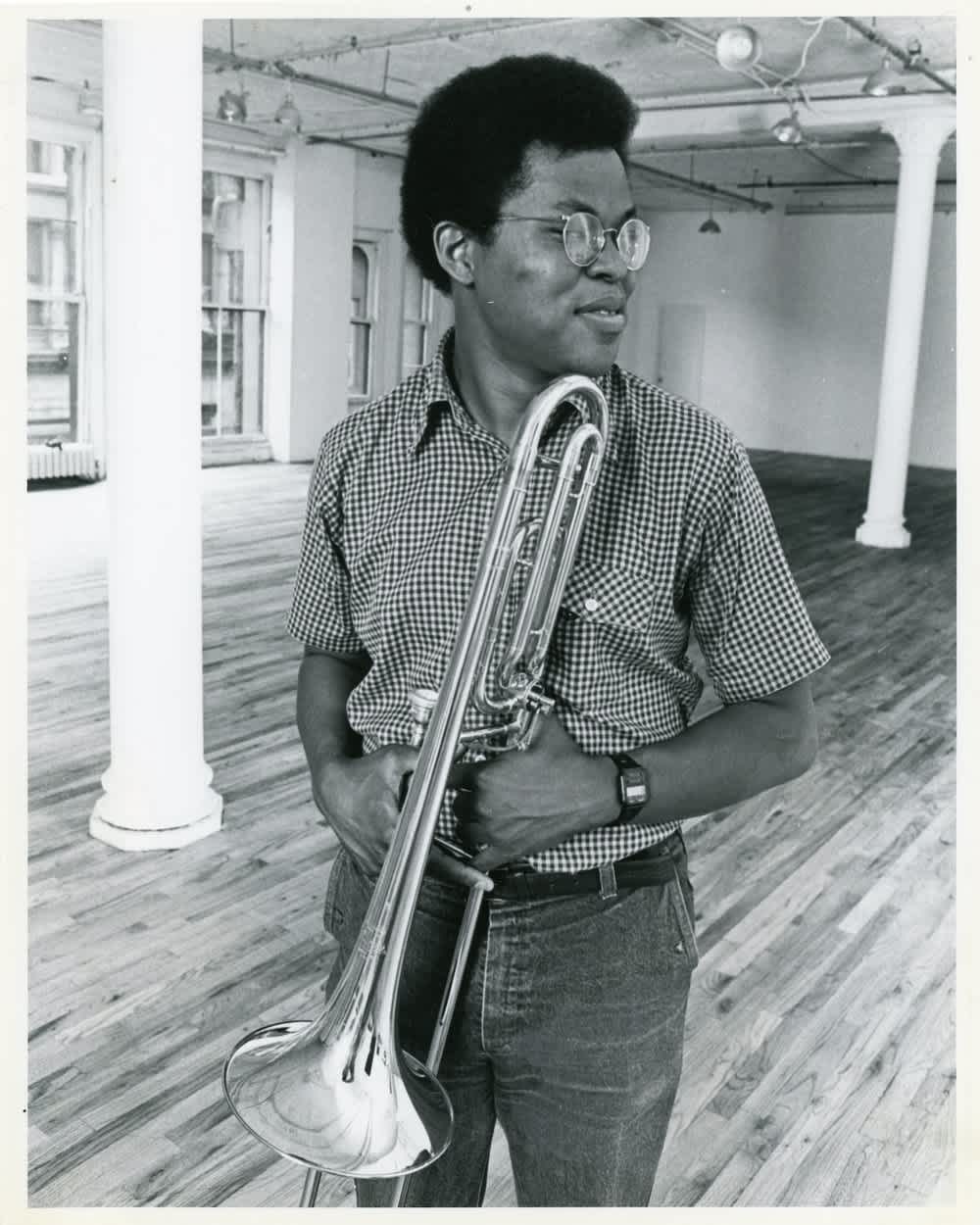
In October of 2008, The Kitchen hosted A Power Stronger Than Itself: A Celebration of The Association for the Advancement of Creative Musicians, curated by George Lewis and Christopher McIntyre. Following the publication that same year of Lewis’s book, A Power Stronger Than Itself: The AACM and American Experimental Music, the event at The Kitchen featured performances, panels, and a book signing. Born out of extensive research and Lewis’s personal experience, the text A Power Stronger Than Itself traces a history of the internationally renowned non-profit organization and collective of musicians and composers Association for the Advancement of Creative Musicians (AACM) by detailing its theoretical, spiritual, political, and aesthetic tenets, as well as its groundbreaking influence on generations of musicians and artists. The AACM was founded in 1965 in Chicago by pianists Muhal Richard Abrams and Jodie Christian, drummer Steve McCall, and trumpeter Philip Cohranan out of a radical collective visioning of individuality and a dedication to creating serious, original music. Lewis’s relationship with the AACM—which he joined as a teenager in 1971, and where he trained in trombone and composition—helped inspire his seminal contributions to the field of computer music.
Lewis also carried the indelible influence of the AACM into the longstanding artistic home he nurtured within the walls of The Kitchen. His earliest involvement here can be traced back to his appearance in the event New Music New York in 1979, where he premiered his first ever computer piece, The Kim and I. In October of the same year, he presented Chamber Music for Humans and Non Humans, an early collaboration between him and fellow AACM member Douglas Ewart. Lewis would later go on to serve as The Kitchen’s Music Director from Fall 1980 to Spring 1982. During his tenure, he programmed AACM and non-AACM musicians whose practices broadly reflected a commitment to experimentation that often challenged traditional categorizations of genre. Following his tenure, Lewis returned to The Kitchen for subsequent collaborations such as “Music of George Lewis,” a performance that was part of Arto Lindsay’s concert series Music…It’s The Ocean (1987), and his performance-installation The Empty Chair (1990). This article will consider these latter two events as paradigmatic of his many experiments at The Kitchen that touched on improvisation, systems, consciousness, and machine-listening and learning, and often bore the remarkable influences of the AACM. With this in mind, we can come to understand the 2008 event A Power Stronger Than Itself as a culmination and convening of the trans-locational, boundary-breaking conversation that Lewis nurtured between the AACM and The Kitchen through his lifelong inquiries.
Lewis and the AACM
By looking more closely at the retrospective resonance of the event A Power Stronger Than Itself, we can come to appreciate the aesthetic and theoretical concerns behind the cross-institutional dialogue that Lewis initiated in his work. Consisting of two nights of performance on October 9 and 11, 2008, A Power Stronger Than Itself featured, according to its press release, a “cross-generational variety of artists.” Among them were original AACM members Amina Claudine Meyers, Roscoe Mitchell, Wadada Leo Smith, and New York City Chapter President and founding member Muhal Richard Abrams, under whom Lewis studied directly. The event also featured more recent AACM members, such as flutist and Chicago chapter co-president Nicole Mitchell and saxophonist Matana Roberts. In addition, the program included New York-based artists who were “not affiliated but nonetheless make music in the spirit of the collective’s diversity” such as the Wet Ink ensemble. [1] The event bookended a Friday evening concert at the Community Church of New York sponsored by the New York AACM chapter featuring members Oliver Lake and Reggie Nicholson.
While the range of featured performers indicates that the event brought together a rich array of the theoretical and aesthetic influences nurtured by AACM musicians, Lewis’s writing offers additional insight into how this evening of performances reflects the evolution of AACM philosophies over time. The printed program accompanying the event included passages of text sourced from Lewis’s article “Experimental Music in Black and White: The AACM in New York, 1970–1985,” originally published in Current Musicology in 2002. As many fascinating threads can be extracted from this article and his subsequent book, I have narrowed in on the notions of self and collectivity, improvisation, and systems to examine how Lewis bridged his learnings from the AACM with his work at The Kitchen.
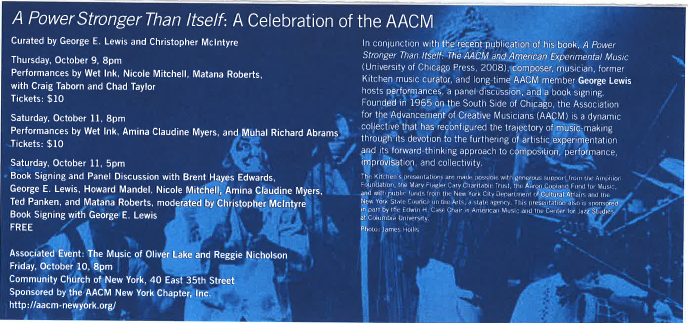
The AACM was founded in “the virtually all-black side of Chicago in 1965” as a project that, according to Abrams, was dedicated to exploring “how the disadvantaged can come together to determine their own strategies for political and economic freedom, thereby determining their own destinies.” [2] In a section of the article not included in the program, Lewis contextualizes the founding of the AACM in the wake of the Black Power Movement and Black Arts Movement, quoting AACM member and drummer Don Moye’s assertion that both organization and defiance are important strategies of resistance. With a desire to break free from the white-dominated categorizations of aesthetics and the constrictions and expectations of jazz, the organization would dedicate its first-ever meeting to negotiating the meaning of “original music”—the porous, fluctuating, and ultimately undefinable thread along which AACM members would mold their practice. In many ways, this notion of originality refers to the question of how individuality can be nurtured within a collective framework. [3] These explorations gave rise to the organization’s iconoclastic, heterogeneous, and ever-evolving musical production over the decades. Many have come to articulate that there is no distinct AACM sound; rather, the AACM’s sonic output is an embodiment of a boundless dedication to self-expression as it aligns to the greater purposes of collectivity, decolonization, and liberation.
In addition to writing about the self’s inextricable relationship to the collective in the AACM, Lewis highlights how members of the organization understand the self in relation to its potential. [4] This notion is central to his own work, as he expresses in an Artforum interview with artist Terry Adkins: “Well, when you ask whether something is fixed or improvised, even in human terms, the part of what we do that’s improvised comes from a part of us that we don’t know much about. We assume that we have infinite potential, but we don’t actually know whether we have intrinsic limits. So we have to assume that we don’t, in order to save ourselves psychologically.” In a 2020 lecture on his book for The Library of Congress, Lewis expanded on this idea of self-as-potential, speaking on the pedagogical function of improvisation. He defines teaching as an improvisational practice that mirrors the improvisational nature of life itself. In the struggle to understand ourselves in relation to the other, improvisation creates pathways for new experience in the minds of performers and audience members, but also in the world at large. The title of Lewis’s book references philosopher Yves Citton, who posits that the power of improvisation lies in the ecstatic bodily experience of limitlessness: “We can and we must believe that which we thought unbelievable, can be done by individual and collective bodies, once they invent a diagram capable of releasing a power stronger than itself.” [5]
While Lewis’s understanding of improvisation conceives of a self that exists in relation to its untapped potential, he also expounds the importance of a self that is firmly planted within the sonic traditions of previous generations and in Black musical tradition at large. Lewis quotes Gene Easton’s contribution to the first AACM meeting, in which he poignantly encapsulates this cross-temporal dynamic: “As we learn more of other systems of music around the world, we’re getting closer to the music that our ancestors played—sound-conscious musicians, finding a complete new system that expresses us. Because there are far better systems, and I feel that we will be locked up for the rest of our days in this system unless we can get out of it through some means such as this.” [6] Easton’s articulation of systems has become a fundamental reference for how Lewis speaks on his practices. He has subsequently described this notion of systems as the cultural paradigms into which we are “locked”—the imagination or mythology embedded in the software of life and culture. [7] In this way, Lewis’s “creative-machines” can be read as examples of Citton’s idea of a musical diagram, which, by releasing the unknown potential of the improvising mind, might offer alternate models of living in relation.
Lewis and The Kitchen
While Lewis put the inquiries highlighted above into practice throughout his long-standing relationship with The Kitchen, two examples stand out as distinctly telling of how he would engage notions of improvisation, interrelation, consciousness, and systems in the performances he staged here: “Music of George Lewis” in Music…It’s The Ocean in 1987 and his interactive piece The Empty Chair in 1990 demonstrate how the AACM drive to re-envision historical, cultural, spiritual, and social structures resonates in his work.
On May 1, 1987, The Kitchen hosted “Music of George Lewis,” as part of the series Music…It’s The Ocean. The evening featured Lewis’s 1984 composition Rainbow Family performed by J.D. Parran on clarinet [8], and later by Lewis on trombone. The evening also featured David Behrman and Lewis’s 1986 Kalimbascope and Lewis’s 1987 piece Quick Study. Rainbow Family was the first of Lewis’s interactive virtual orchestra pieces. First performed to a full house at the lnstitut de Recherche et Coordination Acoustique/Musique (IRCAM) in Paris to much acclaim, the work incorporates algorithms Lewis designed to run through a set of computers and control synthesizers. [9] Lewis’s software generated music in real time while also responding to improvising musicians.
In the accompanying event program to “Music of George Lewis,” Lewis delineated many of the theoretical and technical aspects behind Rainbow Family, which he defines as a “real time composing and listening machine” or “RCLM.” He describes how performer and computer are playing by a similar set of rules and influencing each other in the process of co-creating the piece. He also emphasizes his “desire to make palpable the structural thinking of the improvising performer,” a concern that constitutes a fundamental function of the piece and that he hoped would permeate every stage of developing a musical work all the way to the performance. In line with ideas associated with the AACM, Lewis projects this study of individual improvisational thinking to the larger conscious structures of language and culture, describing music as a mechanism for “the recognition and transmission of complexes of symbols,” and, one could extrapolate, a vehicle through which to unlock or transfigure cultural myths or paradigms.
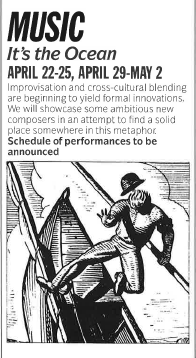
Lewis further elaborates on these notions in his writing in other contexts, describing Rainbow Family as a “small but possibly potent provocation concerning the act of listening.” [10] Underscoring how creative machines offer the possibility to practice improvisation as listening, he frames machine–human relations as a microcosm of the social, in that they stand in for subject–object relations. The dedication to attentive and engaged listening in the context of improvisation, which he defines as a practice of intelligibility, becomes the foundation for a sense of social responsibility towards the other. For Lewis, computers can “teach us to celebrate our place as listeners as part of a continuous, interactive transformation of both Other and Self.” [11] Integrating many of these principles, Kalimbascope was another RCLM, featuring Lewis and Behrman’s compositions, a kalimba player, and music-driven graphics. In its incorporation of the Zimbabwean thumb piano as the instrument of focus, the piece also responded to AACM prerogatives on sourcing from longstanding traditions of Black music from across the world in order to envision new systems. Kalimbascope also emerged from Lewis’s budding interest in making “interactive pieces that can function as public installations.” [12]
Lewis would extend many of these concerns into a subsequent collaboration, The Empty Chair, which originally premiered in the Netherlands in 1986 before being performed at The Kitchen in 1990. Described in the program as “an interactive music video performance” and later by Lewis in an interview as “multi perspectival interactive theater,” the piece sought to transmit the subjective experience of incarceration. Lewis has also referred to the piece as an indirect homage to Nelson Mandela, who was imprisoned at the time of its creation. [13] The piece featured actor Bernard Mixon as the unnamed protagonist and longtime collaborator and AACM member composer and musician Douglas Ewart as “a spirit.” [14] The performance also featured Don Ritter and Ray Edgar as “music-driven computer controlled image processing music performers.” These two performers helped control video screens through their own computer systems, which featured both animation and live synthesized imagery. Lewis operated a computer that sonically responded to the performance.
In the event program accompanying The Empty Chair at The Kitchen, Lewis describes the piece as an invitation to explore the “mind of a composite ‘model’ prisoner…where what we might see and hear is a kind of living exploded diagram of this mind.” This notion situates the work in dialogue with AACM principles in relation to Citton’s idea of improvisational music as a diagram. Setting his diagrammatic experiment against the conceptual backdrop of the prison, Lewis contrasted a locality inherently defined by its limits with the limitlessness of the human self. He highlights his goal in creating performance as “immersing everyone present, performers and listeners, in an interactive environment, optimized for contemplation” where “multiple streams of consciousness are manifested through juxtaposition of media and modes of imagery.” [15] In this way, Lewis positions the audience in a context of radical intelligibility, where they are faced with the phantasm of the prison. Against this binding structure, the improvisational dialogue struggles and generates an alternate conscious structure.
Lewis also highlights that The Empty Chair mirrors life itself in that no audience member will be able to grasp and assimilate all of the content, and no “official road map” will be given. He notes that because of the piece’s fundamentally improvisational nature, no performance will be the same. Moreover, he emphasizes the importance of trust in the interpersonal environment of creating performance and thanks his collaborators for their willingness to venture into new realms of expression. Trust holds an equally important place in the relationship between computers and live performers in his work, and Lewis reminds us that “‘non humanity’ need not be equated with ‘inhumanity.’”
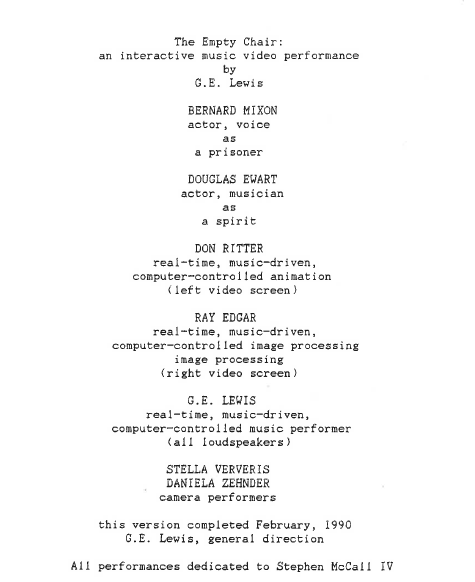
An Event that Resonates Forward
In the program for the event A Power Stronger Than Itself, Lewis describes how the AACM would fundamentally challenge conventional understandings of American experimental music, “obliging the recognition of a multicultural multi-ethnic reality with a variety of perspectives, histories, traditions and methods,” and influencing artists across disciplines, generations, and geographies. Lewis brings to the fore how despite this, AACM members were often given far less credit than their white downtown contemporaries. His work organizing this 2008 event is just one example of how Lewis has breached innumerable gaps in recognition through scholarship and collaboration throughout his long career of cross-disciplinary, cross-institutional experimentation. Marking a moment that in many ways has been a long time coming, this year’s Kitchen Gala honors Lewis as an artist whose work continues to resonate forward through the seminal developments in improvisational computer music he nurtured at The Kitchen and elsewhere and his contributions to AACM’s radical boundary-breaking practices.
Images: 1) George Lewis, Portrait at The Kitchen. 1980. Photo by Johan Elbers. 2) The Kitchen brochure listing for A Power Stronger Than Itself: A Celebration of the Association for the Advancement of Creative Musicians at The Kitchen, October 9–11, 2008. 3) May 1987 calendar of programming, listing for Music…It’s The Ocean at The Kitchen, April 22–May 2, 1987. Detail. 4) Program for George Lewis, The Empty Chair at The Kitchen, February 24–25, 1990. Detail. To see the full program, see here.
Footnotes:
[1] Press Release for A Power Stronger Than Itself: A Celebration of The Association for the Advancement of Creative Musicians at The Kitchen, October 9-11, 2008.
[2] Program for A Power Stronger Than Itself: A Celebration of The Association for the Advancement of Creative Musicians at The Kitchen, October 9-11, 2008.
[3] This vision of individual self-expression stems in part from longstanding traditions of originality in Black music. Lewis points to the notion of “one’s own sound” which “by definition constitutes something as new to the world as one's very own birth, and therefore cannot have been heard before.” George Lewis, "Experimental Music in Black and White: The AACM in New York, 1970-1985." Current Musicology, no. 71-73, Feb. 2002. 109.
[4] Roscoe Mitchell refers to this notion as stretching out the self: “I mean, I think we should all try to go into ourselves and stretch out as far as we can.” Lewis, "Experimental Music in Black and White," 104.
[5] George Lewis, "A Power Stronger Than Itself: The AACM." Library of Congress, Feb. 26 2020. https://www.loc.gov/item/webcast-9697
[6] Lewis, "Experimental Music in Black and White," 104.
[7] In his Library of Congress lecture, Lewis speaks on the notion of phantasm, coined by digital media scholar Fox Harrell. Phantasms are the pervasive beliefs that influence every aspect of daily experience For Harrell and Lewis, phantasms are “primordial sources of power” with the potential to both emancipate and oppress.
[8] Lewis describes Parran in the program as “the kind of clarinetist that the piece was made for.”
[9] According to Paul Steinbeck in his article “George Lewis’s Voyager,” it was largely thanks to his connections at The Kitchen that Lewis secured a residency at IRCAM. Rainbow Family is also a direct predecessor to Voyager , which is considered “a major breakthrough in ‘human-computer interaction,’” and which, according to Steinbeck, bore considerable theoretical influences from the practices of the AACM.
[10] George Lewis, "Rainbow Family." Technosphere Magazine, 23 Dec. 2018. https://www.technosphere-magazine.hkw.de/p/5-Rainbow-Family-5Aj9nAxzG6zFRAAd9icEvH
[11] Ibid.
[12] Program for "Music of George Lewis" at The Kitchen, May 1, 1987.
[13] George Lewis and Terry Adkins, “EVENT SCORES: TERRY ADKINS AND GEORGE LEWIS IN CONVERSATION.” Artforum, Mar. 2014. https://www.artforum.com/print/201403/terry-adkins-and-george-lewis-in-conversation-45294
[14] According to Bernard Holland’s review in the New York Times featured in Lewis’s archive, Ewart evoked “African roots with his wooden flute and rattle and more modern permutations of the black experience through his surrealistic attacks on the saxophone.”
[15] Program for George Lewis, The Empty Chair at The Kitchen, February 24–25, 1990.

